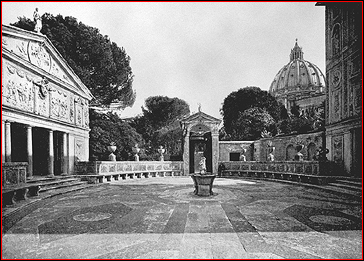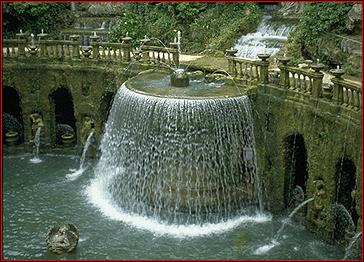Pirro Ligorio
c. 1510-1583
LIFE
Early Career
Pirro Ligorio was born in Naples, where he began his career as a painter. Around 1534 he moved to Rome, and his early work there included fresco decoration in yellow grisaille on the façades of Roman palaces.
Ligorio became interested in antiquities by the 1540s, and devoted much time to excavation, study, and publication.
Patronage by the Papacy
Ligorio's entry into papal service as an architect began with the election of fellow-Neapolitan Pope Paul IV. In 1558, Ligorio became the chief architect of the Belvedere Court project at the Vatican. He added several major features to the court and designed a papal retreat resembling a tiny villa to the west of it.
After the death of Michelangelo in 1564, Pius IV appointed Ligorio to replace him as chief architect of St. Peter's. According to Giorgio Vasari, Pius V relieved Pirro Ligorio as chief architect at St. Peter's and other Vatican projects in 1566 because he intended to change Michelangelo's design, but he did not state where the change was to be made. Although some architectural historians believe that Ligorio made the windows of the attic story of St. Peter's more decorative than Michelangelo had intended, its current state is generally assumed to reflect Michelangelo's final design, which is believed to be represented by Dupérac's elevation. Ligorio's intention to deviate from Michelangelo's design led to his being relieved of authority at St. Peter's and other Vatican projects in 1566.
Patronage by the Este Family
After leaving the Vatican projects in 1566, Ligorio worked full time as an architect for Cardinal Ippolito d'Este, who had appointed him as court archaeologist back in 1549.
Ligorio's most important work for the Cardinal is the Villa d'Este (1565-72), a highly influential garden with many large fountains.
In 1567, Ligorio moved to Ferrara, a city in the region of northern Italy that was dominated by the Este family, and the following year he was appointed court antiquary to Ippolito's nephew Alfonso II d'Este, who was the Duke of Ferrara. Ligorio continued to work for the Este family until his death in 1583.
LIGORIO'S ANTIQUARIANISM
Antiquarianism
Antiquarianism, a term derived from "antique," refers to having a taste for or devotion to antiquities. Ligorio, who was at the forefront of archaeological investigation in the Renaissance, was one of the foremost antiquarians of his time.
Excavations and Publications
In the 1540s Ligorio began making archaeological investigations of Rome's antiquities, making numerous excavations of ancient sites. In the 1560s, while planning the nearby garden villa of Cardinal d'Este, who was also the Governor of Tivoli, Ligorio excavated Hadrian's villa and uncovered many ancient sculptures, which were taken to the new villa.
In the 1550s and early 1560s, Ligorio published many of his findings, including notes on his collections, archaeological maps, and two encyclopedias of antiquities. The information collected by Ligorio, which is known from his publications and the many unpublished manuscripts that have been found in Naples and Turin, has been an important source of knowledge about Roman antiquities in the sixteenth century.
Incorporation of Antiquities in Architecture
Ligorio used authentically Roman materials, especially ornamental plaster over brick, which could be modeled to resemble Roman relief sculpture.
The entire façade of the Casino of Pius IV, is covered by an assemblage of reliefs, inscriptions, and motifs that treat the building's surface as a plane for ornament.
Accentuation of Ornament over Structure
With respect to his favoring ornament over structure, Ligorio can be considered the opposite of Bramante.
WORKS
Works at the Vatican, 1558-66
Many of Ligorio's works in Rome were at the Vatican.
Pope Paul IV appointed Ligorio chief architect of the Vatican Palace in 1558, when the focus of building activity was the Belvedere Court project. In the eight years of his period in this position, which largely coincided with the papacy of Pope Pius IV (1559-65), he worked on several of its parts.
♦West Gallery, Belvedere Court. Ligorio constructed much of the west wing of the Belvedere Court.
♦Roman-Style Theater, Belvedere Court. At the south end, Ligorio added a theater that had a semicircular-shaped area of seating like those of ancient Roman theaters.
♦Nicchione, Belvedere Court. Ligorio created the Nicchione, which means "Big niche" in Italian, by adding a hood-like semi-dome to the exedra at the north end.
♦Stairs Connecting Middle and Upper Levels, Belvedere Court. Ligorio carried out Bramante's design for a dual-ramp staircase that extended all the way across the court between the upper and middle courts.
♦Casino of Pope Pius IV. In 1558 Pirro Ligorio began a small villa known as the Casino of Pius IV in the gardens to the west of the Belvedere Court of the Vatican complex. It was begun for Pope Paul IV and completed under his successor, Pius IV, for whom it is named. The main level is organized around an elliptical court that must be entered through gates on the lateral sides. The principal two buildings are the casino proper and the loggia, which stand opposite each other on the main axis. Their façades are covered by stucco reliefs imitating ancient relief sculpture. From the loggia on the rear of the east pavilion, visitors can see the pool and fountain, which are part of the nymphaeum located on a lower level. The original parterre was changed in the eighteenth century, and today that part of the Vatican grounds has a park-like appearance.
♦Parts of drum and attic of St. Peter's. After Michelangelo's death in 1564, Ligorio was appointed head architect at St. Peter's by Pius IV. It is uncertain what he built in the year or two he was there, but he is believed to have completed the entablature of the drum and worked on the attic story on the north apse. According to Giorgio Vasari, Pius V relieved Pirro Ligorio as chief architect at St. Peter's and other Vatican projects in 1566 because he intended to change Michelangelo's design, but he did not state where the change was to be made. Although some architectural historians believe that Ligorio made the windows of the attic story of St. Peter's more decorative than Michelangelo had intended, its current state is generally assumed to reflect Michelangelo's final design, which is believed to be represented by Dupérac's elevation.
Works Outside Rome
Ligorio worked for the Este family on a villa near Rome and on a number of urban projects in Ferrara.
♦Villa d'Este, Tivoli, 1565-72. Ligorio designed the Villa d'Este at Tivoli near Rome for Cardinal Ippolito d'Este. The gardens were laid out geometrically in a grid-like configuration of walkways and staircases. Accentuated features, mostly large fountains, were symmetrically located at the center and outer areas. Water diverted from the Aniene River enters the garden above the Oval Fountain from a long tunnel. From there, the water flows to other fountains such as the Wall of the Hundred Fountains, the Rometta, the Dragon Fountain, and the Organ Fountain. Today the gardens are overgrown, and the all-important central view from the uppermost terrace is marred by tall trees. Many original features such as works of sculpture and the cross-shaped vine-covered pergola of the parterre are no longer present.



 Add Placemark
Add Placemark Go Back
Go Back 






